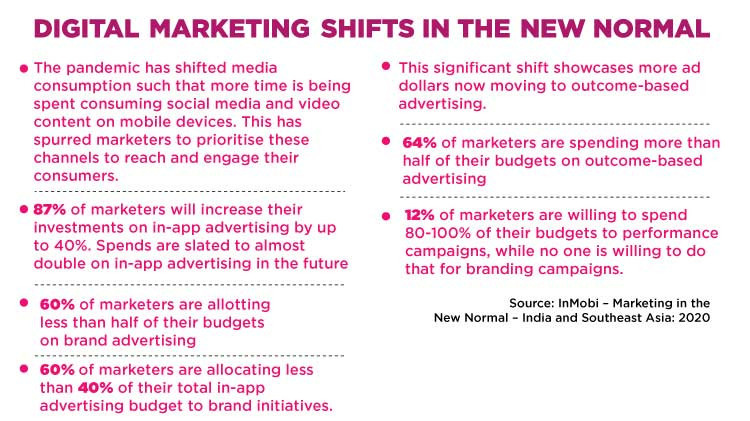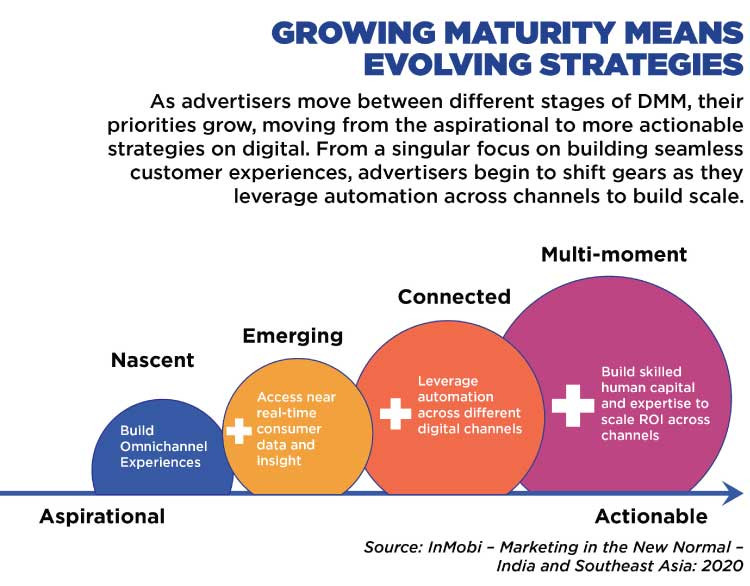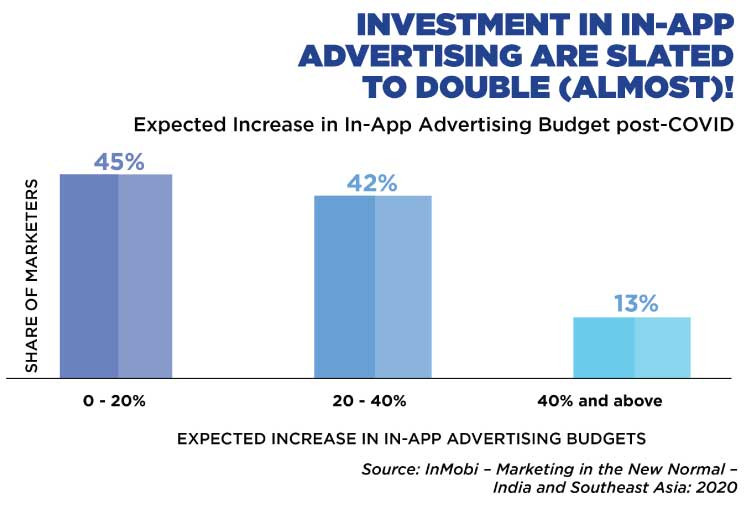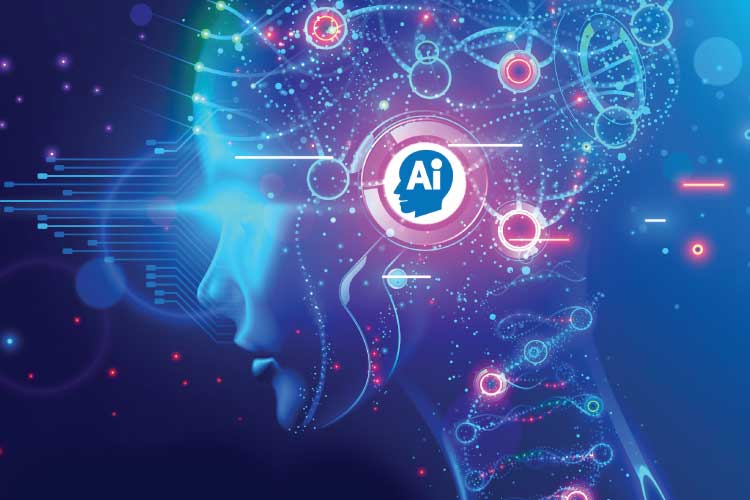The ongoing pandemic has underscored the need for enhanced digital-first strategies by brands and agencies. With MarTech and AI affirming their presence in the industry, just how much of an impact will these make in the industry in the future?
Will performance advertising on Digital still drive growth as margins are better for agencies? Furthermore, will huge investments in MarTech and AI yield the desired results for marketers? Although digital-first marketers are comfortable with performance, marketing technology has assumed greater importance with artificial intelligence being leveraged in the entire marketing funnel. This gives a much larger canvas to influence and impact media performance. That eventually brings us to understand that a combination of all three – MarTech, AI and performance marketing will continue to act as the growth drivers in this space. Agencies have had to make investments in performance marketing. However, they also need to adopt to MarTech and AI technologies and bring it in their campaign’s DNA in order to stay relevant to clients and their consumers.
Better yields from performance marketing
In times of uncertainty, performance marketing is making a bigger mark in the world of digital marketing. It is working under the microscope with radical transparency. With the help of performance marketing, agencies can ensure accurate targeting capabilities along with detailed analytics. This gives agencies a unique opportunity to hit the advertiser’s audience and save a lot of what could be wasted in vain.
Media agencies make it easy for both parties to keep track of clicks and conversions; and they recommend performance strategies like native advertising, sponsored content, affiliate marketing, social media advertising, search engine marketing, and so on to advertisers. “Organisations are looking at performance marketing as one more aspect of their strategy for customer acquisition, reach, and engagement. Media agencies who offer a broad range of marketing services are foraying into the world of performance marketing as an additional service to reap the benefits of the growing demand. The scope is huge and complements the existing capabilities of these agencies,” says Ashvin Vellody, Partner, Deloitte India.
According to the InMobi Report of Marketing in the New Normal, Asia and Southeast Asia: 2020, irrespective of whatever the stage of digital marketing maturity that brands are in, their biggest objective remains to acquire new customers. As a direct consequence, outcome based advertising or performance marketing is here to stay with brands and marketers becoming more ROI conscious.
No either / or scenario
According to the same InMobi survey, more than 60% of the respondents planned to allocate less than 40% of their in-app advertising budgets for branding initiatives in the wake of the pandemic. “However, with brands’ ultimate goal being personalised engagement with its consumers, there will not be an either/ or scenario. Innovations in Mar Tech and AdTech, separately as well as intertwined, will continue to help media agencies deliver the required growth for brands. AI and Machine Learning, already showing widespread applications in creative optimisation, dynamic auctions, cost optimisation etc., will only continue to accelerate the innovations in Mar Tech and performance marketing,” says Vasuta Agarwal, Managing Director, Asia Pacific, InMobi.
Shantanu Sirohi, COO, Interactive Avenues – A Reprise Network Company echoes that by saying, “In my view it is not one versus the other, as the drivers of  performance marketing will be MarTech-led, data-driven and AI optimised.” Further talking about the whether it will be performance or MarTech and AI driving growth for the industry further, Sirohi says, “There is the economic principle of risk versus return, and the fact that the two are highly co-related and move in tandem. So obviously, the remuneration can be higher for an agency that is willing to work on a ‘pay for performance’ model. Moreover, the relationship with the client alters dramatically when you become a partner in the true sense with a shared destiny linked to business outcome.”
performance marketing will be MarTech-led, data-driven and AI optimised.” Further talking about the whether it will be performance or MarTech and AI driving growth for the industry further, Sirohi says, “There is the economic principle of risk versus return, and the fact that the two are highly co-related and move in tandem. So obviously, the remuneration can be higher for an agency that is willing to work on a ‘pay for performance’ model. Moreover, the relationship with the client alters dramatically when you become a partner in the true sense with a shared destiny linked to business outcome.”
As digital ecosystem is becoming more competitive and almost reaching a maturity curve where most of the services are commoditised, this understandably is putting more pressure on cost, with clients expecting more for less with ever increasing technical complexity in performance marketing business. “For agencies to maximise profitability, one will have to invest in new age services such as the execution of data audits, the implementation of attribution and measurement tools, increased use of ML and AI algorithms in the decision-making process and helping brands on the path to bringing programmatic buying more deeply into their business,” says Bharat Khatri, Country Head, India- Xaxis.
According to the InMobi Report, as marketers look at acquiring new customers as their top priority, the post COVID world will witness increasing focus on ROI with each ad dollar spent. This has led to most marketers (60% of them) allocating less than 40% of their total in-app advertising budget to brand initiatives. This significant shift showcases more ad dollars now moving to outcome-based advertising. 87% of marketers will increase their investments on in-app advertising by up to 40%. Spends are slated to almost double on in-app advertising in the future.
Clearly, performance marketing is definitely a wide and important area for advertisers and media agencies can play their part in helping brands achieve their objectives. Mediums like search, display and increasingly video have a key role to play when it comes to performance marketing. Data analytics and creative expertise (either in-house or through a partner) become core pillars for driving ROI along with an in-depth understanding of measurement and attribution. “Media agencies need to increasingly build expertise across these channels, latest measurement technologies and frameworks, attribution methodologies and key metrics for effectively driving growth for their clients,” says Agarwal of InMobi.
However the margins in performance marketing are shrinking. “Performance marketing is a specialised operation and margins are only shrinking. However MarTech driven solutions where optimisation happens through a single dashboard across touch points will see big adoption. Programmatic will see massive spikes because that brings in absolute transparency, but these will be on SaaS pricing models and not like how it was run with margins that were otherwise dependent on how one cracks a media deal,” observes Rammohan Sundaram, Country Head and Managing Partner, Integrated Media, DDB Group
Cost efficacy of MarTech and AI investments
Successful digital transformations often come with some significant expenses. But for agencies it is more of a question of survival rather than return on investment. “On the business side, it is the large, legacy system driven enterprises that are scrambling to update their technologies at the risk of getting redundant. While this might be more evident in the fin-tech space, the impact cuts across sectors and industries. From the agency perspective, it is more of a question of survival rather than return on investment. 2021 is the decade of transformation as operational work becomes increasingly automated, creativity is back in the driver seat and delivering measured business outcome becomes our raison d’être,” states Interactive Avenues’ Sirohi.
Leaders are aggressively deploying new tools and cloud infrastructures, as old tech is now becoming the barrier to fast-track digital transformation but these costs on the other hand are also becoming hard to justify as a lot of stakeholders are seeing this as on-time exercise, rather than a continuous process for developing new consumer-centric frameworks that will allow organisations to compete in the future and disrupt or get disrupted.
“Before the pandemic, the share of investments in MarTech was rising, i.e., from 22% of marketing budgets in 2017 to up to 29% in 2019. As the pandemic hit the ground, this growth got affected. The companies were failing to get the desired return on investments in MarTech and for most of the companies, the ROI was negligible. Just a fraction of companies, those with high revenues, have been able to generate the expected ROI. The problem that companies face with MarTech is that they are not quite satisfied with the existing platforms and find the need to build a custom platform for themselves, which requires substantial investment. Not many companies would do that and those who do, are doing it without having the right people, skills, or time to achieve the desired outcome. So, it will take a little while for MarTech and AI to generate the desired ROI for the marketing world, but they will, eventually,” predicts Bhavesh Talreja, Founder and CEO of Globale Media.
“Investments in performance marketing are also huge. Things are moving very fast and we need to be ahead of the curve. We as an agency have made investments and acquired companies because it’s not something that one can grow organically in a short period of time. So we invested ahead of time. Agencies will also need to make investments in MarTech and AI as I feel by 2025, digital is going to be the single largest medium in India, even though Television is very powerful and will remain so. So if agencies don’t invest in this, they will be caught in a time warp, which is already happening to some. It’s got to permeate into the DNA of your agency and the work that it does,” explains Ashish Bhasin, CEO, Asia Pacific and Chairman India, Dentsu.
New scenario, new solutions
The impact of AI is already seen on various levels in the marketing and advertising world. We are seeing widespread applications in creative optimisation, dynamic audience building and targeting, always-on cost optimisation, real-time consumer insights and much more.
By 2022, the global digital spend is expected to touch USD 441 billion, and despite the fact that India is the second largest country in the world after China in terms of internet users, India’s share is barely 1%. “I believe this scenario can only be changed if the Indian digital advertising industry will have innovative solutions to reach out to the right audience at the right time with the right messaging, given India is a challenging market with its inherent cultural, social and economic diversity and huge 130 billion population. In India, finding a customer in digital is equivalent to looking for a needle in the haystack, and won’t be possible for every other platform out there, unless it is backed by strong data intelligence and artificial intelligence. Therefore, I believe India needs more and more investments in MarTech and AI, because that’s the only way the Indian digital landscape will be able to see massive growth,” says Ankit Prasad, Founder & CEO, Bobble AI.
The upcoming demise of third-party cookies has also accelerated the long-term data strategy plan where brands have already started to deploy CDPs (Customer Data Platforms) to transition from a segment audience data approach to individual consumer profiles. “With every brand’s ultimate goal being ‘driving personalised and relevant engagement with its consumers,’ we will see more innovations in Mar Tech and AdTech to build a unified view of the customer. This unified view of the customer will be critical in a multi-channel world where users have multiple touch points with a brand. Especially in the wake of the recent cookie deprecation, we have seen a number of brands invest in personalisation tech stack such as Data Management Platforms (DMPs) and Customer Data Platforms (CDPs). As is the case with most technological innovations, these will soon start yielding results as well,” notes InMobi’s Agarwal.
“Given the increased restrictions on sharing of first party data especially with tech giants planning to block third party cookies, publishers will have to reinvent themselves and consider creating walled garden solutions for themselves. To this effect – we are seeing publishers not only strengthening their data strategy but also reducing their dependence on programmatic by building their own ad stack. In a world where ROI from Digital is yet to established, this model helps publishers to move from capex to opex model, shorten their time to market and yet leverage a platform that allows them more opportunities for performance marketing by creating a direct connect between advertisers and targeted audiences,” points out Girish Menon, Partner and Head, Media and Entertainment, KPMG India.
“The industry will continue to see this trend in both the advertiser and publisher ecosystem on putting more focus towards first party data activation powered with contextual targeting,” says Bharat Khatri, Country Head, India- Xaxis. “On the other hand, AI has already proven its invincible value in the campaign bid optimisation, targeting and segmentation space by delivering better results than human traders over the last few years. It’s time now that brands need to embrace AI to boost personalisation at scale. It’s like feeding an algorithm with historical and real time data and then letting AI perform analysis, build and serve the user hyper-personalised messages. Traditional personalised creative tools were built for targeting customer personas or profiles, where each profile used to represent a category of consumers. However in case of AI personalisation tools it’s like engaging with each customer as an individual profile. With increased social commerce share, AI based hyper-personalisation engines will be the need of hour, as it will improve both ROI and customer experience,” he adds.
“With analytics fuelling sharper insights and targeting, and dynamically-targeted content ensuring that the right message is delivered at the right time, efforts in dynamic pricing, content, social media and asset management, and personalised customer service can all improve the consumer experience. Retargeting will encourage users to take action, thereby boosting return on advertising spends. Overall, investments in marketing technology and artificial intelligence will help boost higher accountability, media effectiveness and deliver better customer experiences,” says Sonali Malaviya, Senior Vice President, Client Services, India and Southeast Asia, Essence.
The changing face of digital advertising
Digital advertising is growing and will continue to grow because of the advent of engaging consumer facing content drivers, and that happens when infrastructure and technology join hands. According to the Pitch Madison Advertising Outlook, Digital is the only medium that grew in 2020 by 10%. Video not only was the largest contributor but has further increased its share from 30% to 32% during the year. Programmatic has taken firm root in Indian Digital AdEx and almost 40% of all Digital spends are through Programmatic, and of course 95% of all digital spends are on Mobile. Both social and display marginally improved their share and all three have grown shares at the expense of search.
As we see massive adoption of gaming and video driving bigger volume on consumptions, more consumers will spend a lot more time on platforms where these technologies will get deployed for better responses to communication. “AI - when a consumer is most receptive to respond or other MarTech opportunities will drive the data driven solutions,” states DDB Mudra Group’s Sundaram. “Performance marketing is an outcome of these initiatives and that will continue to grow but not at the pace at which brand advertising will, as we get into 2022 and beyond. So Video, eCommerce, Social and Gaming will be big and that is where Brands will latch onto any opportunities that will come their way for growth,” he adds.
As marketers sharpen their focus on outcome-based spends and increased ROI, it is clear that performance marketing, AI and MarTech will be key to brand strategies in the future.























